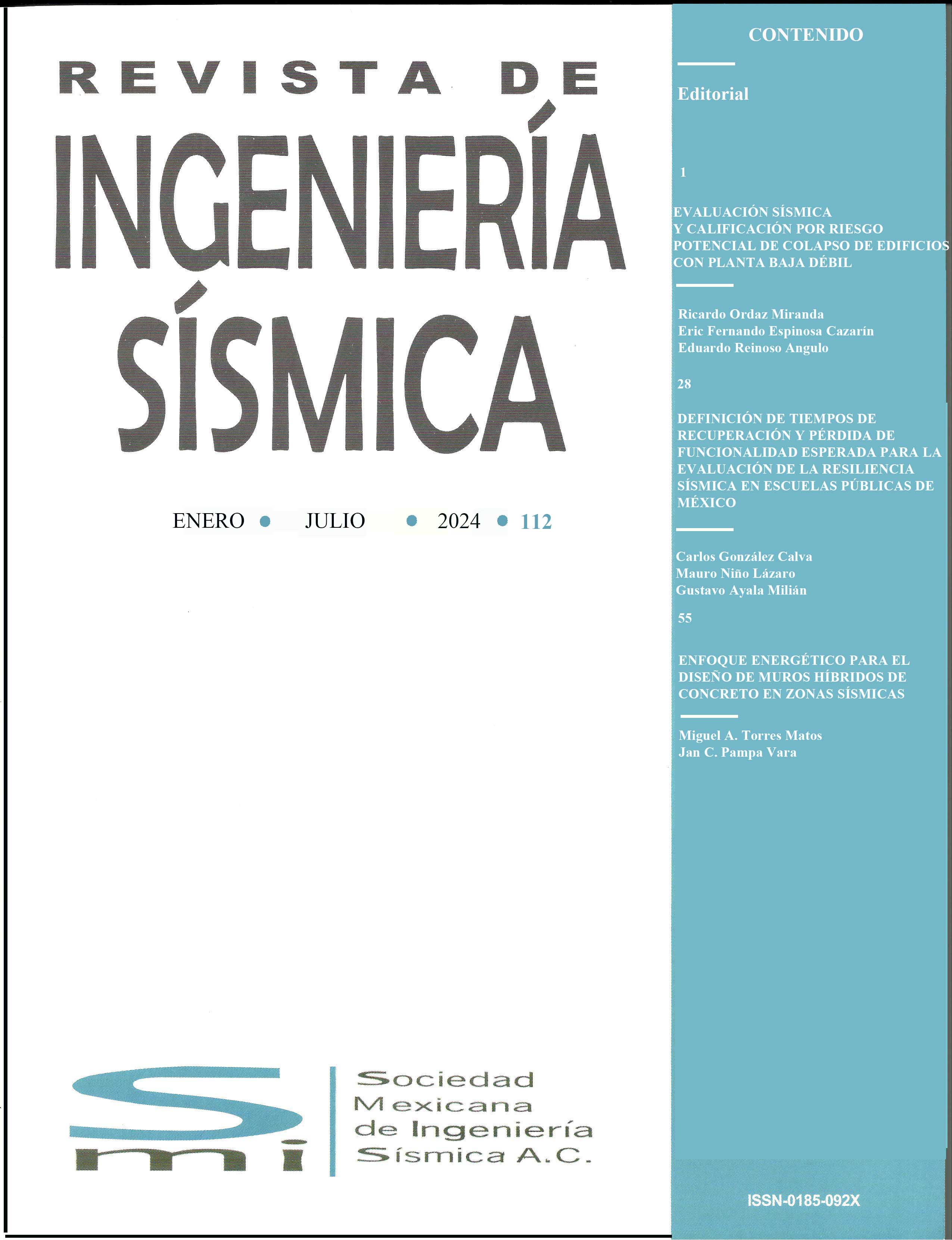SEISMIC BEHAVIOR OF BUILDINGS WITH FRICTION ISOLATORS IN THE LAKEBED ZONE OF MEXICO CITY
DOI:
https://doi.org/10.18867/ris.107.584Keywords:
Friction pendulum isolators, incremental dynamic analysis, probability of collapse of isolated structures, Steel frame structures, Lakebed Zone of Mexico CityAbstract
Historically, it has been established that using base isolation in the Lakebed Zone of Mexico City is not a feasible alternative. This is due to the existing soft soil deposits in that area and their predominant long periods of vibration. However, recent technology developments, such as friction pendulum isolators (FPI), are an interesting alternative worth to explore, which can help to improve the City's seismic resilience. In that sense, this paper explores the use of FPI on medium- and low-rise steel buildings in the Lakebed Zone of Mexico City. Three-, six- and nine-storey high models, in 2D, were studied for three different cases. Case 0, which was taken as a benchmark, corresponded to conventional fixed-base buildings (i.e. without FPI), designed to resist both gravitational loads and seismic demands. Case 1 corresponded to the same structures of Case 0, but the structures were mounted on FPI. Case 2 corresponded to the buildings of Case 1 with FPI, but their superstructure was redesigned considering gravitational loads only. The seismic behavior of the buildings was evaluated in terms of: i) maximum inter-storey drift; ii) maximum lateral displacements; iii) maximum floor velocities; iv) maximum floor accelerations; v) maximum inter-storey shear; and vi) maximum overturning moment. Twelve synthetic and two historic seismic ground motions were used for a site with a predominant period of vibration close to 2 s. They were scaled to different intensities in order to conduct incremental dynamic analysis (ADI). Finally, the probability of collapse of the studied buildings was estimated. The results indicate that the probability of collapse on isolated buildings with FPI was lower than that for conventional buildings. Advantages of using FPI in the Lakebed Zone of Mexico City are presented and discussed, while some significant differences between cases 1 and 2 were identified.
Downloads
References
Aguilar, H J (2020), “Comportamiento sísmico de edificios con aisladores de péndulo de fricción en la zona del lago de la Ciudad de México”, Tesis de maestría, Programa de Maestría y Doctorado, UNAM, Ciudad de México.
Al-Hussaini, T M, V A Zayas y M C Constantinou (1994), Seismic isolation of multi-story frame structures using spherical sliding isolation systems, National Center for Earthquake Engineering Research, Technical Report NCEER-94-0007, Nueva York, EUA. pp. 182.
ASCE 41-17 (2017). Seismic evaluation and retrofit of existing buildings. American Society of Civil Engineers. Estados Unidos de Norte América.
Benjamin, J R y C A Cornell (1970), Probability, statistics and decisions for civil engineers, Mc Graw Hill, U.S.A. pp. 640.
Cardone, D, G Perrone y V Piesco (2018), “Developing collapse fragility curves for base‐isolated buildings”, Earthquake Engineering and Structural Dynamics, Vol. 48, pp. 78-102. DOI: 10.1002/eqe.3126
Constantinou, M, A Mokha y A Reinhorn (1990), “Teflon bearings in base isolation II: modeling”, Journal of Structural Engineering, Vol. 116, No. 2, pp. 455-474. DOI: 10.1061/(ASCE)0733-9445(1990)116:2(455)
Elenas, A y K Meskouris (2001). “Correlation study between seismic acceleration parameters and damage indices of structures” Engineering Structures. Vol. 23, pp. 698-704. DOI: 10.1016/S0141-0296(00)00074-2
ETABS (2016), Programa de análisis estructural de edificios, Computers and Structures, Inc.
FEMA P695(2009), Quantification of building seismic performance factors, FEMA P695, Federal Emergency Management Agency, Washington, D.C, EUA, pp. 421.
FEMA P-58 (2012), Seismic performance assessment of buildings, Vol. 1, Report FEMA P-58, Federal Emergency Management Agency, Washington DC, EUA, pp. 278.
Guerrero, H, A Terán-Gilmore, T Ji y J A Escobar (2017), “Evaluation of the economic benefits of using buckling-restrained braces in hospital structures located in very soft soils”, Engineering Structures, Vol. 136, No. 2, pp. 406-419. DOI: 10.1016/j.engstruct.2017.01.038
Joy, R y C K Prasad (2016), “Seismic vulnerability assessment of tall RC building with friction pendulum bearing system”, SSRG International Journal of Civil Engineering, Vol. 3, pp. 1-8. DOI: /10.14445/23488352/IJCE-V3I8P101
Naeim, F y J M Kelly (1999), Design of seismic isolated structures: From theory to practice, John Wiley & Sons, Inc., pp. 296.
NTC-DS (2020), Normas técnicas complementarias para diseño por sismo, Gaceta Oficial de la Ciudad de México, No. 220 Bis., Ciudad de México.
SASID (2020) [Ap. Web], Sistema de acciones sísmicas de diseño, Reglamento de Construcciones del Gobierno de la Ciudad de México.
Reinoso, E (2007), Riesgo sísmico de la Ciudad de México, UNAM, Ciudad de México, pp. 50.
Rosenblueth, E y L Esteva (1972), “Reliability basis for some Mexican codes”, Probabilistic Design of Reinforced Concrete Buildings, ACI Publication SP-31, pp. 1-41.
Rosenblueth, E y M Ordaz (1987), “Use of seismic data from similar regions”, Earthquake Engineering &. Structural Dynamics, Vol. 15, pp. 619-634. DOI: 10.1002/eqe.4290150507
Tena, A (2016), “Método simplificado para el diseño de estructuras con base en muros de carga aisladas sísmicamente”, Sociedad Mexicana de Ingeniería Estructural, XX Congreso Nacional de Ingeniería Estructural, Yucatán, México, pp. 25.
Vamvatsikos, D y C A Cornell (2002), “Incremental dynamic analysis”, Earthquake Engineering and Structural Dynamics, Vol. 31, pp. 491-514. DOI: 10.1002/eqe.141
Zayas, V A, S S Low y S A Mahin (1990), “A simple pendulum technique for achieving seismic isolation”, Earthquake Spectra, Vol. 6, No. 2, pp. 317-333. DOI: 10.1193/1.1585573

Downloads
Published
How to Cite
Issue
Section
License
Copyright (c) 2022 Revista de Ingeniería Sísmica

This work is licensed under a Creative Commons Attribution-NonCommercial 4.0 International License.





